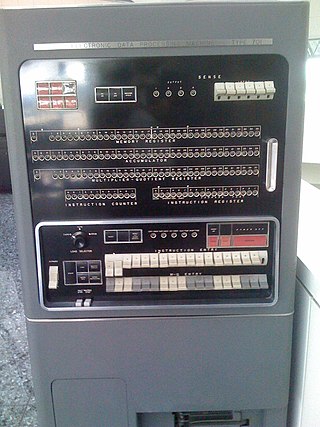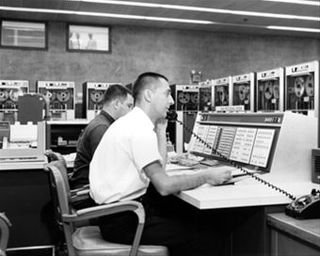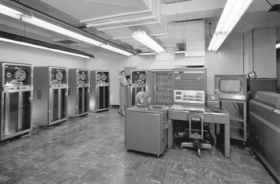
A tape drive is a data storage device that reads and writes data on a magnetic tape. Magnetic-tape data storage is typically used for offline, archival data storage. Tape media generally has a favorable unit cost and a long archival stability.

The IBM 704 is the model name of a large digital mainframe computer introduced by IBM in 1954. It was the first mass-produced computer with hardware for floating-point arithmetic. The IBM 704 Manual of operation states:
The type 704 Electronic Data-Processing Machine is a large-scale, high-speed electronic calculator controlled by an internally stored program of the single address type.

The IBM 1620 was announced by IBM on October 21, 1959, and marketed as an inexpensive scientific computer. After a total production of about two thousand machines, it was withdrawn on November 19, 1970. Modified versions of the 1620 were used as the CPU of the IBM 1710 and IBM 1720 Industrial Process Control Systems.

The IBM 650 Magnetic Drum Data-Processing Machine is an early digital computer produced by IBM in the mid-1950s. It was the first mass-produced computer in the world. Almost 2,000 systems were produced, the last in 1962, and it was the first computer to make a meaningful profit. The first one was installed in late 1954 and it was the most popular computer of the 1950s.

The IBM 701 Electronic Data Processing Machine, known as the Defense Calculator while in development, was IBM’s first commercial scientific computer and its first series production mainframe computer, which was announced to the public on May 21, 1952. It was designed and developed by Jerrier Haddad and Nathaniel Rochester and was based on the IAS machine at Princeton.

The IBM 700/7000 series is a series of large-scale (mainframe) computer systems that were made by IBM through the 1950s and early 1960s. The series includes several different, incompatible processor architectures. The 700s use vacuum-tube logic and were made obsolete by the introduction of the transistorized 7000s. The 7000s, in turn, were eventually replaced with System/360, which was announced in 1964. However the 360/65, the first 360 powerful enough to replace 7000s, did not become available until November 1965. Early problems with OS/360 and the high cost of converting software kept many 7000s in service for years afterward.

The IBM 305 RAMAC was the first commercial computer that used a moving-head hard disk drive for secondary storage. The system was publicly announced on September 14, 1956, with test units already installed at the U.S. Navy and at private corporations. RAMAC stood for "Random Access Method of Accounting and Control", as its design was motivated by the need for real-time accounting in business.

The IBM 729 Magnetic Tape Unit was IBM's iconic tape mass storage system from the late 1950s through the mid-1960s. Part of the IBM 7-track family of tape units, it was used on late 700, most 7000 and many 1400 series computers. Like its predecessor, the IBM 727 and many successors, the 729 used 1⁄2 inch (13 mm) magnetic tape up to 2,400 feet (730 m) long wound on reels up to 10+1⁄2 inches (270 mm) diameter. To allow rapid tape acceleration, long vacuum columns were placed between the tape reels and the read/write heads to absorb sudden increases in tape tension which would otherwise break the tape. Write protection was provided by a removable plastic ring in the back of the tape reel.

The UNISERVO tape drive was the primary I/O device on the UNIVAC I computer. It was the first tape drive for a commercially sold computer.

The IBM 702 was an early generation tube-based digital computer produced by IBM in the early to mid-1950s. It was the company's response to Remington Rand's UNIVAC, which was the first mainframe computer to use magnetic tapes. As these machines were aimed at the business market, they lacked the leading-edge computational power of the IBM 701 and ERA 1103, which were favored for scientific computing, weather forecasting, the aircraft industry, and the military and intelligence communities.
The 3480 tape format is a magnetic tape data storage format developed by IBM. The tape is one-half inch (13 mm) wide and is packaged in a 4 in × 5 in × 1 in cartridge. The cartridge contains a single reel; the takeup reel is inside the tape drive.
The Massbus is a high-performance computer input/output bus designed in the 1970s by Digital Equipment Corporation (DEC). The architecture development was sponsored by Gordon Bell and John Levy was the principal architect.

IBM's first magnetic-tape data storage devices, introduced in 1952, use what is now generally known as 7-track tape. The magnetic tape is 1⁄2 inch (13 mm) wide, and there are six data tracks plus one parity track for a total of seven parallel tracks that span the length of the tape. Data is stored as six-bit characters, with each bit of the character and the additional parity bit stored in a different track.

9-track tape is a format for magnetic-tape data storage, introduced with the IBM System/360 in 1964. The 1⁄2 inch (12.7 mm) wide magnetic tape media and reels have the same size as the earlier IBM 7-track format it replaced, but the new format has eight data tracks and one parity track for a total of nine parallel tracks. Data is stored as 8-bit characters, spanning the full width of the tape. Various recording methods have been employed during its lifetime as tape speed and data density increased, including PE, GCR, and NRZI. Tapes come in various sizes up to 3,600 feet (1,100 m) in length.
Magnetic-tape data storage is a system for storing digital information on magnetic tape using digital recording.

The IBM 7080 was a variable word length BCD transistor computer in the IBM 700/7000 series commercial architecture line, introduced in August 1961, that provided an upgrade path from the vacuum-tube IBM 705 computer.

The IBM 7330 Magnetic Tape Unit was IBM's low-cost tape mass storage system through the 1960s. Part of the IBM 7 track family of tape units, it was used mostly on 1400 series computers and the IBM 7040/7044. The 7330 used 1⁄2 inch (12.7 mm) magnetic tape up to 2,400 feet (730 m) long wound on reels up to 10+1⁄2 inches (266.7 mm) diameter.

The IBM Naval Ordnance Research Calculator (NORC) was a one-of-a-kind first-generation computer built by IBM for the United States Navy's Bureau of Ordnance. It went into service in December 1954 and was likely the most powerful computer at the time. The Naval Ordnance Research Calculator (NORC), was built at the Watson Scientific Computing Laboratory under the direction of Wallace Eckert.

A vacuum-tube computer, now termed a first-generation computer, is a computer that uses vacuum tubes for logic circuitry. While the history of mechanical aids to computation goes back centuries, if not millennia, the history of vacuum tube computers is confined to the middle of the 20th century. Lee De Forest invented the triode in 1906. The first example of using vacuum tubes for computation, the Atanasoff–Berry computer, was demonstrated in 1939. Vacuum-tube computers were initially one-of-a-kind designs, but commercial models were introduced in the 1950s and sold in volumes ranging from single digits to thousands of units. By the early 1960s vacuum tube computers were obsolete, superseded by second-generation transistorized computers.

















